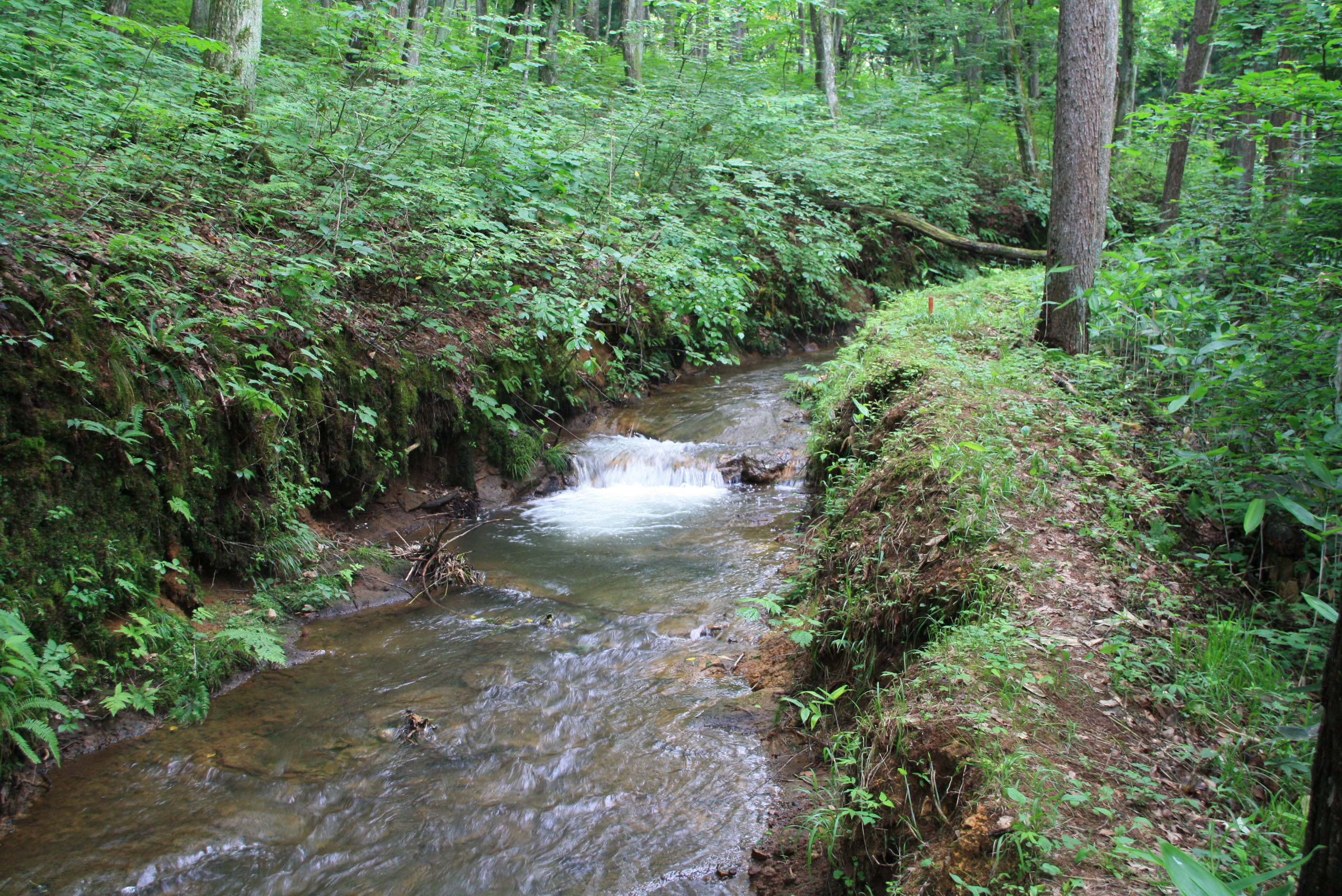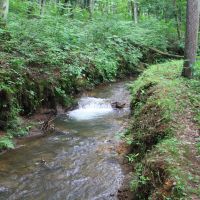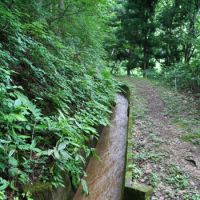A watercourse runs between our Afan Trust woods and a national forest up here in the northern Nagano Prefecture hills — passing, for just a few hundred meters, through our property as well.
Old-timers tell me the watercourse was built sometime during the Edo Period (1603-1867), and although nobody knows exactly when, it still wonderfully serves its purpose of diverting a pure mountain stream down to the rice paddies below.
This man-made irrigation channel must have been a major feat of planning and execution. Cut into the slopes of the mountain in dense forest, those old samurai engineers ensured it had just enough gradient to convey the water without it running too fast to be populated by tasty wild char and the aquatic insects they need to survive.
And, as was customary in those days, only local materials were used — originally, hard clay with some rock support on steep curves. In fact, a visiting National Geographic contributor recently suggested our humble ditch ought to perhaps be designated as a cultural treasure.
Sadly, though, when Japan's ongoing obsession with concrete began in the mid-20th century, local officials started meddling. In the 1960s, they destroyed one section of the old watercourse and turned it into a three-sided concrete sluice in which nothing could survive. There, in fact, I once saw a 1½-meter snake being washed down, unable to get out. Likewise, a small creature falling in would probably die, and char and aquatic insects can't negotiate this section.
In other parts, meanwhile, the meddlers just lined the outer sides of the watercourse with concrete slabs, leaving the inner, uphill sides in their natural state. This is not so bad for aquatic life, though it's nowhere as good as the original.
In the 28 years that I have observed this watercourse, the only places it's ever overflowed have been where the original flow has been narrowed due to the construction of a concrete wall. In contrast, and despite some serious floods over the years, the original — untampered with — watercourse has never broken its banks, and those last original sections have riffles, pools and little water slides that delight the children who visit our woods. The pools, too, are the homes of char and the nymphs of dragonflies and mayflies, while the water is so enriched with oxygen that it must be excellent for the rice paddies.
This spring, a pair of bureaucrats, one from the prefectural offices, the other from our town hall, came in their pristine pale-gray uniforms together with a small delegation of local rice farmers to tell me they were going to replace this last remnant of the original Edo Period watercourse with concrete — at a cost of about ¥100 million ($1.3 million). This would wipe out the char and other aquatic life and make the stream too dangerous for children to play in.
"Oh no you won't," said I, since they need permission from our woodland trust to cross our property to the watercourse. Apart from the damage to the watercourse, they would have to cut down trees and tear up a lot of ground to carry out their scheme.
As long as I am chairman of the C.W. Nicol Afan Woodland Trust, that will not happen.
The usual arguments were trotted out: What will happen if that part floods? Who will take responsibility?
Well, it hasn't flooded so far, and even if it did, it would overflow into our land — which doesn't trouble us in the least.
I pointed out that Japan is a signatory to the international Convention on Biological Diversity agreed in Rio de Janeiro, Brazil, on June 5, 1992, and ratified at the Conference of the Parties in Nagoya in 2010. Moreover, when it came to taking responsibility, no bureaucrat in this country ever really takes responsibility for anything. If there is any bother, they just get shifted out of the way.
The locals were sour-faced, not because the quality or supply of water for their rice paddies would be any better for all that concrete — but because they liked the idea of construction money coming to their community (even though last time a non-local contractor got the job).
For my part, I said that if they convinced me that the construction was absolutely essential I might agree, but I would insist on entirely natural materials being used. To that end, heaped on land nearby and eminently suited for stream construction are tons of rocks and boulders retrieved from the River Torii after being washed down in a massive flood some years ago.
The bureaucrats then said that using rocks would cost twice as much — but how they got that figure, I don't know. "Have you ever built with rocks?" I asked, and the answer was no.
The argument went on, and in June (as I reported here last month in "A lesson in respecting river life") I invited them to our new Afan Centre to attend an illustrated lecture by river experts from Canada and Japan on how river construction with natural materials is not only safe, but also improves the environment for fish and everything else.
That time, the town hall official came 20 minutes late — and fell asleep. No prefectural officials bothered to show up at all — even though leading Japanese experts had came from as far as Shikoku and Niigata Prefecture.
Consequently, mystery remains over that ¥100 million cost estimate — since it took roughly the same amount to modify 37 km of a river in Canada damaged by erosion triggered by clear-cut logging and bring back char, steelhead trout and two species of salmon, along with terrestrial wildlife that depends on the fish.
I will not allow access to build a concrete travesty on this watercourse, and if my and our trust's wishes are somehow overcome, I will personally hire lawyers and experts and take the town, the prefecture and the officials responsible to court for wasting public funds, ignoring the rules on biodiversity, damaging the image and environment of our trust — and severely pissing off Old Nic.
Oh, how I get my knickers in a dreadful twist when bossy bureaucrats waste my time and get paid for it. On the other hand, I cooperate as much as I can with the nice, polite and efficient ones — though those are rarely linked to the construction industry.
If the locals get upset with me because this make-work money is allocated elsewhere, then that's too bad. I'm not in a popularity contest and somebody has to stand up for the fish and the scenery.
Here in Japan, public apathy and timidity in the face of officialdom has seen the destruction of hundreds of major rivers and many thousands of tributaries, streams and waterways that once were rich in aquatic life.
It doesn't have to be that way; 17 years ago, I stood up for the River Torii and won, forcing the authorities to abandon plans for flood-control measures using tons of concrete, and making them do the work using natural boulders instead.
There's reckoned to be freedom of speech in Japan — and it's about time we all used it.





















With your current subscription plan you can comment on stories. However, before writing your first comment, please create a display name in the Profile section of your subscriber account page.